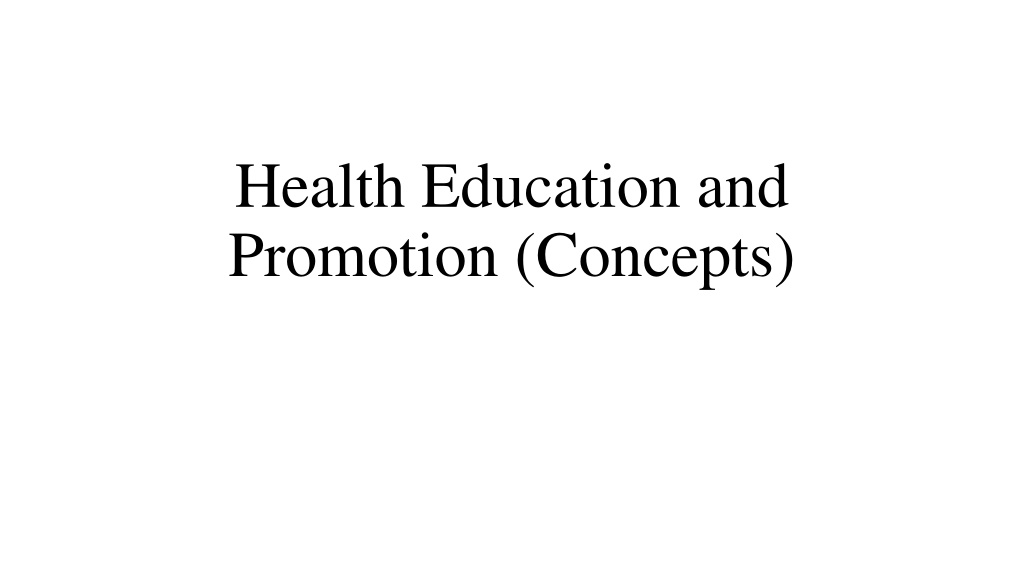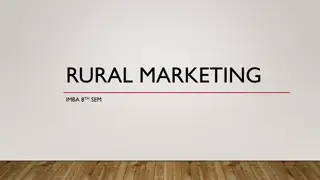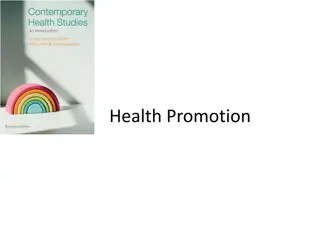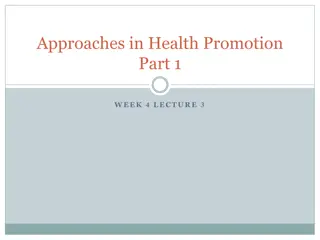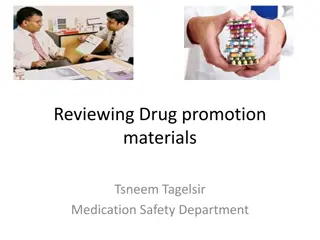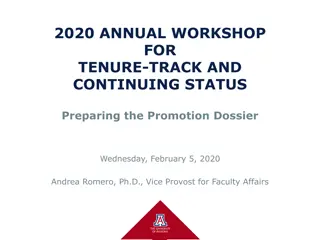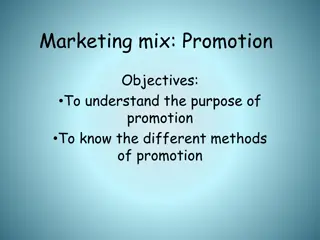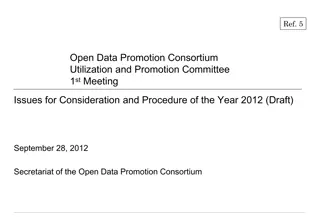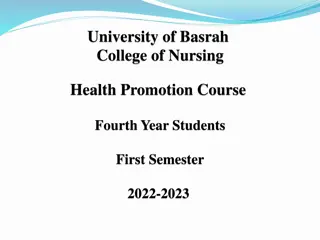Understanding Health Education and Promotion Concepts
Health education aims to improve health by increasing knowledge and influencing attitudes. It involves disseminating health knowledge, empowering individuals to identify and solve health problems, and promoting healthy behaviors. Health promotion goes beyond individual behavior to focus on social and environmental interventions. Disease prevention strategies include vaccination, health risk information, nutritional programs, and dental hygiene education.
Download Presentation

Please find below an Image/Link to download the presentation.
The content on the website is provided AS IS for your information and personal use only. It may not be sold, licensed, or shared on other websites without obtaining consent from the author. Download presentation by click this link. If you encounter any issues during the download, it is possible that the publisher has removed the file from their server.
E N D
Presentation Transcript
Health Education and Promotion (Concepts)
Objectives Define "health education" and state its aims Explain the role of health education in relation to the stage of disease prevention Identify the factors that influence human behavior Discuss the factors that contribute to behavior change Define learning and identify the domains of learning Outline the Health Belief Model of behavior change Describe the trans-theoretical model of stages of motivation List the direct and indirect methods of communicating health messages State the strength and limitation of each method of communicating health messages State the types and values of audiovisual aids in facilitating the transfer of health messages
Health Education Health education is any combination of learning experiences designed to help individuals and communities improve their health, by increasing their knowledge or influencing their attitudes (WHO)
Aims of Health Education Disseminate concepts sound health knowledge in the community. Enable people to identify their health problems and needs. Help people in solving their health problems using their potential. Build normal health trends. Establish proper health behavior and the wrong change to true healthy behavior. The ultimate goal of health education is: improve the health of the individual and community level. Reduce the incidence of disease. Reduction of disabilities and deaths. Improve the quality of life for the individual and society
health promotion The process of enabling people to increase control over, and to improve, their health. It moves beyond a focus on individual behavior towards a wide range of social and environmental interventions.
Health Education / Disease Prevention Primary prevention : Vaccination and post-exposure prophylaxis of children, adults and the elderly Provision of information on behavioural and medical health risks, and measures to reduce risks at the individual and population levels Inclusion of disease prevention programmes at primary and specialized health care levels, such as access to preventive services (ex. counselling) Nutritional and food supplementation Dental hygiene education and oral health services.
Health Education / Disease Prevention Secondary prevention : Population-based screening programmes for early detection of diseases Provision of maternal and child health programmes, including screening and prevention of congenital malformations Provision of chemo-prophylactic agents to control risk factors (e.g., hypertension)
Health promotion Policies and interventions to address tobacco, alcohol, physical activity and diet (e.g., FCTC , DPAS , alcohol strategy and NCD best-buys) Dietary and nutritional intervention should also appropriately tackle malnutrition, defined as a condition that arises from eating a diet in which certain nutrients are lacking, in excess (too high in intake), or in the wrong proportions Intersectoral policies and health services interventions to address mental health and substance abuse Strategies to promote sexual and reproductive health, including through health education and increased access to sexual and reproductive health, and family planning services Strategies to tackle domestic violence, including public awareness campaigns; treatment and protection of victims; and linkage with law enforcement and social services. http://www.emro.who.int/ar/about-who/public-health-functions/health-promotion-disease-prevention.html
Factors influence human behaviors intrapersonal, interpersonal, organizational, community, public policy Social Environmental Behavioral/ Lifestyle Cultural
Factors Influence Human Behaviors Social Environmental Family structure Neighborhood Racism Behavioral/ Lifestyle Diet Substance abuse Exercise Seat belt use Cultural Religion Ethnicity Values and meanings of health and illness
Factors Influence Human Behaviors 1-intrapersonal or individual factors. HBM 2-interpersonal factors 3- institutional or organizational factors 4- community factors 5- public policy
Health Belief Model (HBM) addresses the individual s perceptions of the threat posed by a health problem (susceptibility, severity), the benefits of avoiding the threat, and factors influencing the decision to act (barriers, cues to action, and self-efficacy).
Health Belief Model (HBM) Is heuristic device for organizing component of a domain of a phenomena to show relationships between the parts and the outcome of interest. is a psychological model that attempts to explain and predict health behavior This is done by focusing on the attitudes and beliefs of individuals.
Health Belief Model (HBM) The HBM was first developed in the 1950s by social psychologists Hochbaum, Rosenstock and Kegels working in the U.S. Public Health Services. The model was developed in response to the failure of a free tuberculosis (TB) health screening program.
Health Belief Model (HBM) Despite the fact that this service was offered without charge in a variety of convenient locations, the program was of limited success. The question was, Why? What was encouraging or discouraging people from participating in the programs.
Health Belief Model (HBM) They theorized that people s beliefs about whether or not they were susceptible to disease , and their perceptions of the benefits of trying to avoid it, influenced their readiness to act.
Health Belief Model (HBM) The HBM was first developed in the 1950s by social psychologists Hochbaum, Rosenstock and Kegels working in the U.S. Public Health Services. The model was developed in response to the failure of a free tuberculosis (TB) health screening program.
Health Belief Model Concepts 1.perceived susceptibility 2.perceived severity 3.perceived benefits 4.perceived barriers 5.cue to action 6.self-efficacy Threaten Expectation Expectation
Health Belief Model Concepts 1.perceived susceptibility providing education about prevalence and incidence of disease, individualized estimates of risk, 2.perceived severity information about the consequences of disease (e.g., medical, financial, and social consequences
Health Belief Model Concepts 3-perceived benefits by providing information about the efficacy of recommended behavior to reduce risk of disease 4-Perceived barriers identifying common perceived barriers, and engaging social support or other resources to overcome these barriers
Health Belief Model Concepts 5-Cue to action May provide cues to action to remind and encourage individuals to engage in health- promoting behaviors. -Media -personal influence reminders signs and symptoms
Health Belief Model Concepts 6- self-efficacy Interventions may also aim to boost self-efficacy by providing training in specific health-promoting behaviors
Concept Definition Application Potential change strategies Define population(s) at risk, risk levels; personalize risk based on a person's features or behavior; heighten perceived susceptibility if too low. Perceived Susceptibility One's opinion of chances of getting a condition Perceived Severity One's opinion of how serious a condition and its consequences are One's belief in the efficacy of the advised action to reduce risk or seriousness of impact One's opinion of the tangible and psychological costs of the advised action Strategies to activate "readiness" Specify consequences of the risk and the condition Perceived Benefits Define action to take; how, where, when; clarify the positive effects to be expected. Perceived Barriers Identify and reduce barriers through reassurance, incentives, assistance. Cues to Action Provide how-to information, promote awareness, reminders. Provide training, guidance in performing action. Self-Efficacy Confidence in one's ability to take action
Trans-theoretical Model Of Stages Of Motivation Model has been set out in a number of different ways to illustrate the stages that a person often goes through on the path to change Person attempts to change a behavior, he or she moves through five stages: 1. Pre-contemplation 2. contemplation 3. preparation 4. action 5. maintenance
Trans-theoretical Model Of Stages Of Motivation Whether individuals use self-management methods or take part in professional programs, they go through the same stages of change. Nonetheless, the manner in which they pass through these stages may vary, depending on the type of behavior change.
Trans-theoretical Model Of Stages Of Motivation The Model is circular, not linear. people do not systematically progress from one stage to the next, ultimately graduating from the behavior change process. Instead, they may enter the change process at any stage, relapse to an earlier stage, and begin the process once more. They may cycle through this process repeatedly, and the process can truncate at any point.
Methods and media for communicating health massages One way or didactic method Two way or socratic method
One way or didactic method Lecture Extensively practiced and widely used method Lecture should not exceed more than 20 minutes It should be complete with the fundamental facts and information The lecture should arouse interest in people
Two way or socratic method Group Discussion very useful when there is a common topic of interest Role of group leader is influential in group discussion. Group leader initiates discussion, extends the debate, control the discussion Whole proceedings are recorded by the recorder, at the end conclusion. The number of members in a group may be from 6-20 This method includes panel discussion, workshop, symposium, role playing, demonstration and simulation
Mass media Mass media are one way communication. Television Radio Internet Newspapers Printed material Direct mailing Folk media
